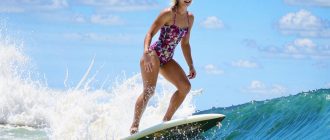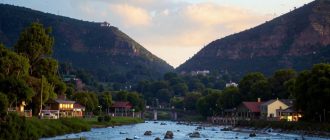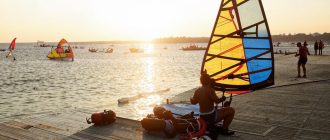
President of Pro-Vision, author of the Vinogradov.story community
“Having said goodbye to the Russian sea at the end of September, most travelers forget about it at least until May, studiously ignoring everything that happens on the coast in winter. And there is a lot of interesting and even extreme things happening there. Why the best sea in winter is not the Red Sea and Andaman Sea, but the Barents Sea and the Sea of Okhotsk, I will tell you below. And I will remind you which winter water sports you should try before the end of the cold season.
Winter surfing in Kamchatka
Surfing in the icy waters of the Pacific Ocean is a sport so not for everyone that even experienced surfers get to Kamchatka quite rarely. Is it worth talking about beginners? Those who dare to stand on a board at the edge of the world experience the most powerful stress – but the stress is positive: two-three hours of riding compensate for the long road, and low temperature, and crazy fatigue.
Skating in Kamchatka is most often done on the Khalaktyrsky beach, but by agreement with an instructor you can find another suitable place. But going to the ocean alone is strictly not recommended – in addition to the usual for surfing injuries, you can also get frostbite. However, as a rule, the training program includes hot tea and a bath – with proper preparation it is unlikely to freeze.

Ice diving on the Teletskoye Lake
Due to the minimal impact on the ecosystem, diving is considered one of the safest sports for nature, and therefore it is allowed even in protected areas. Among them is the legendary Teletskoye Lake in Altai.
The “high” diving season starts in February, when you can already feel the breath of spring around, and the ice “sings” and creates alien sound effects. The landscape that comes off when diving depends not only on the brightness of the sun’s rays, but also on the thickness of the snow cover on the ice. However, in any case it is something cosmic and different from anything that can be seen “up there”. The experience is unique at every stage: from preparing the mine to “thawing” at the primus after the dive.

Ice-floating in the Kola Bay and the Barents Sea
Against the background of energy-consuming and very active diving or surfing this option may seem almost meditation. Ice-floating is very clear and accessible: the swimmer wears a special wetsuit and is released to bob on the waves among ice blocks. His task is to relax and rest as much as possible.
You can do this in the Murmansk region, in the Kola Bay or the Barents Sea. Well, if swimming beyond the Arctic Circle is not associated with rest, you can consider the experience of neighboring Finland: there Ice Floating is a very popular and popular procedure, which is considered an “Arctic spa”.

Snowkiting on the Gulf of Finland
Snowkiting is a winter “twin” of kitesurfing, where instead of a board one skis, snowboards or even skates. This sport is very demanding to the weather. For comfortable riding you need at least minimal wind and a large open space – in this sense the Gulf of Finland is ideal.
Kite schools work mainly on its northern shore, behind Sestroretsk, but in recent years they have been opening in the city limits, for example, near Lakhta. Before getting under the kite, you should refresh or improve your skiing or snowboarding skills – this will help you feel more confident on the ice and concentrate on kite control.
Winter half marathon on the ice of the Sea of Japan or Lake Baikal
Instead of surface or ground – thick “singing” ice, instead of comfortable temperature – light “minus” and wind, which happens only on open water. These are the conditions in which winter ice trails take place, the most famous of which are held in Baikal and Vladivostok, near the Sea of Japan.
Every year about 100 participants come to the start of the Far East Half Marathon, many of whom come from the other side of the country for the race. In such a company it becomes much easier to cover the distance, and the chance of reaching the finish line increases many times over.






